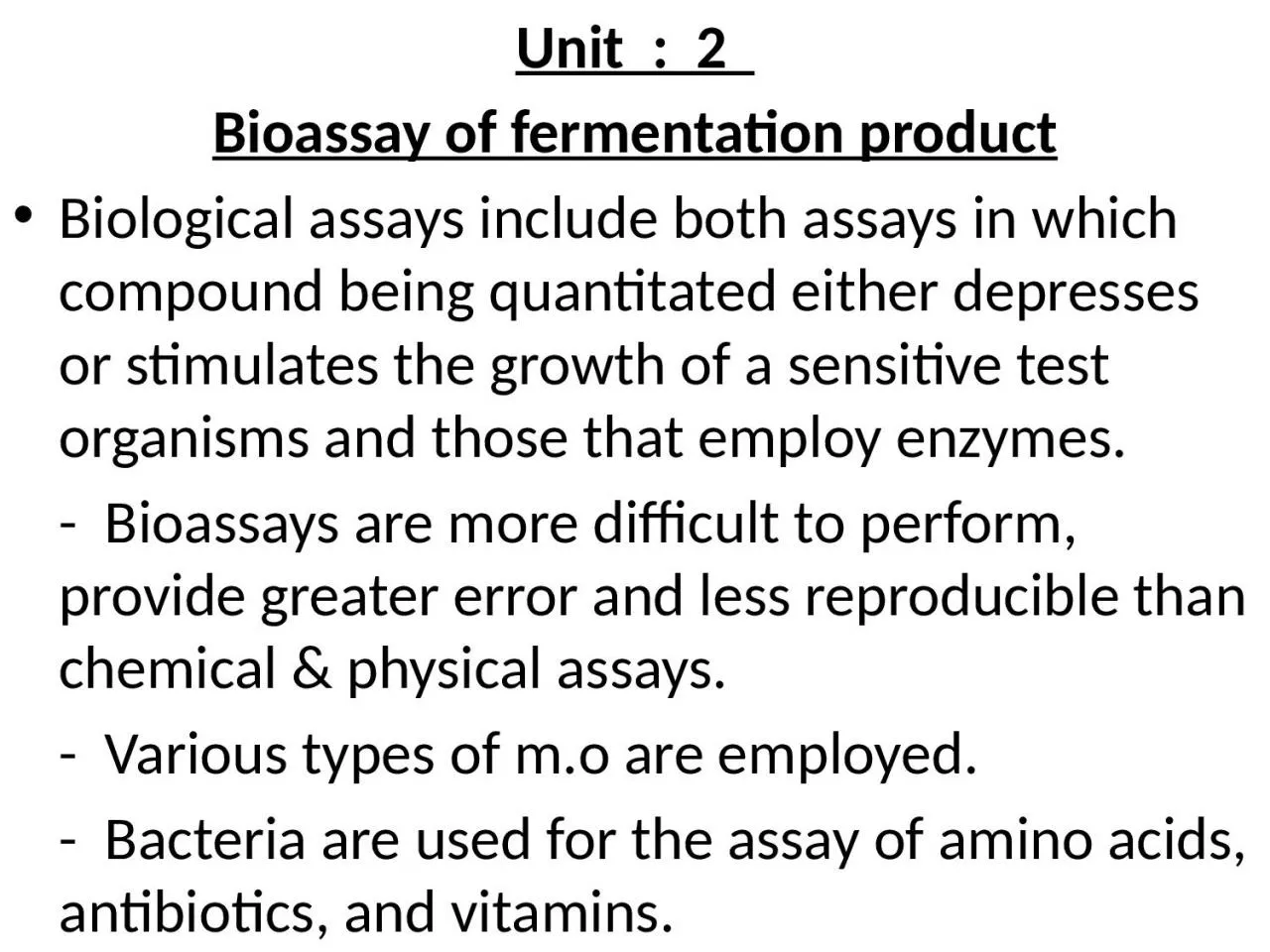

product Biological assays include both assays in which compound being quantitated either depresses or stimulates the growth of a sensitive test organisms and those that employ enzymes Bioassays are more difficult to perform provide greater error and less reproducible than chemical amp ID: 914879
Download Presentation The PPT/PDF document "Unit : 2 Bioassay of fermentation" is the property of its rightful owner. Permission is granted to download and print the materials on this web site for personal, non-commercial use only, and to display it on your personal computer provided you do not modify the materials and that you retain all copyright notices contained in the materials. By downloading content from our website, you accept the terms of this agreement.
Slide1
Unit : 2
Bioassay
of fermentation
product
Biological assays include both assays in which compound being
quantitated
either depresses or stimulates the growth of a sensitive test organisms and those that employ enzymes.
- Bioassays are more difficult to perform, provide greater error and less reproducible than chemical & physical assays.
- Various types of
m.o
are employed.
- Bacteria are used for the assay of amino acids, antibiotics, and vitamins.
Slide2- Yeasts are used in vitamins and antibiotic assays.
- Fungi for vitamins, trace metals, antibiotics, and fungicidal and
fungistatic
materials.
- Protozoan –
Euglena
gracilis
used in Vitamin B12 assay.
Requirements for a
good test Organisms
:
1. It should be genetically stable.
2. It should respond in a graded manner only to a test compound and not to the other materials.
Slide33. should grow relatively quickly on a simple media.
4. should not be pathogen.
5. should grow in a fashion that facilitates reading the assay.
i.e
the cells should not clump in
turbidimetric
assays or swarm across the agar surface for diffusion assays.
6. Should be aerobic or facultative aerobe as anaerobic assays are difficult to perform and require special equipment.
7. Should grow well at a pH that does not affect the stability or toxicity of the material.
Slide4Biological assays fall in to four groups :
Diffusion Assays
Turbidimetric
and Growth Assays
Metabolic Response Assays
Enzymatic Assays
Diffusion Assays :
Diffusion assays are carried out on a solid
Agar medium – suitable for the growth of the
test organism.
- Compound to assayed is allowed to diffuse
through the medium in a radial fashion
Slide5from a cup so that the growth of the test organism is either depressed with antibiotic or stimulated with a growth factor (vitamins).
- diameter of this area reflects the concentration of the compound being assayed and is compared with similar zones produced by known concentrations of standard compound.
Slide6There are Two types of Diffusion assays :
- Cylinder method : antibiotic solution or other fermentation product diffuses from a reservoir or Cylinder in to the surrounding agar.
- Paper Disc method : Defined amount of fermentation solution(0.1ml) is applied to the disc.
Slide7Slide8Turbidimetric
and Growth Assays :
- The effect of the compound under test in liquid culture is measured as increased or decreased turbidity associated with the growth rate or total growth of M.O.
- Series of tubes with a suitable liquid medium are added with material to be assayed in a graded amount.
- Tubes are inoculated with test organism, and incubated.
- Reading are taken as O.D or absorbance.
- The O.D is plotted against the conc. of Standard to obtain a standard curve.
Slide9Slide10End point determination assays :
-
End point assay is employed when the Microbial
growth occurs as a pellicle on the surface of the medium or cells clump at bottom.
- series of tubes of growth medium containing
serially diluted compound
(
e.g
Antibiotic) , is inoculated with test organism and incubated.
- each tube is observed to determine the presence or absence of growth.
Slide11-
The last tube that does not show growth
in the dilution series is equivalent to a dilution of the compound/ fermentation broth.
e.g
if the last dilution is 1/64, then approximately 64 dilution units /ml of the compound present.
- Dilution units are of value when the fermentation product is newly discovered and the standard reference is not available.
Slide12Metabolic Response assays :
-
Similar to
turbidimetric
assays, except that, instead of measuring the effect of the product on the growth of test organism, we measure its
effect on some metabolic reaction during growth.
-
e.g
Acid production, CO2 evolution, O2 absorption and Enzyme
dehydrogenase
activity.
Slide13Enzymatic Assays :
- Enzymatic assays are highly specific and will quantitatively detect minute amounts of a fermentation product as well as differentiate between biologically active and inactive forms of compound.
- Enzyme preparation is incubated with a sample of culture broth so as to cause some
enzyme mediated change in the fermentation product
such as partial decomposition with formation of measurable product.
Slide14- e.g. L-
Glutamic
acid in a sample of fermentation broth can be assayed by adding washed cells of
E.coli
contain the enzyme
glutamic
acid
decarboxylase
. Toluene is added to this mixture to liberate the enzyme from the cells and the assay is carried out at pH-5.
- One mole of CO2 is liberated from each mole of
glutamic
acid.
- The CO2 is poorly soluble in water at this pH, is evolved to the atmosphere as the gas and measured by
manometric
means with a
Warburg
Respirometer
.